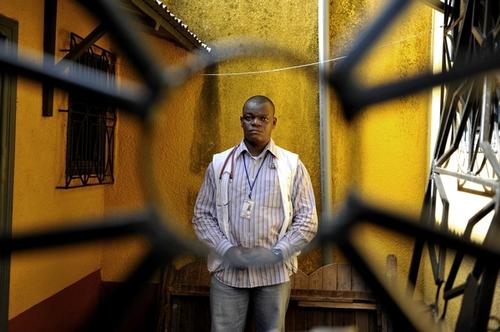A doctor from Cote d’Ivoire, Armel Kone has been with MSF since 2007. After working in Côte d’Ivoire, Malawi and Haiti, he has just spent almost a year assisting Central Africans. From the horrors of Bangui to the exodus of Muslims from Central African Republic to Sido in Chad, Dr Armel recounts his frenetic year in a country in utter chaos.
December 2013: the horror of Bangui
The first time MSF contacted me about CAR was a few days after 5 December 2013. That was the day anti-Balaka fighters attacked the capital Bangui and began persecuting and committing atrocities against the country’s Muslims.
After working as an emergency physician in Haiti, I was hoping to have some time off. But, on 11 December, I landed in Bangui. The situation was so chaotic that I barely had time to drop off my bags at the MSF base before getting down to work at the Community Hospital. I think we admitted 855 people in just one month…
From Bangui to Bozoum: a long and arduous road
On 10 January, we were on our way to Bozoum in the west of the country to open a programme when ex-Seleka rebels stopped our car. They stole all our belongings, MSF stickers and the radio and took off in the vehicle. They brought it back the next day, clean and carefully washed, even the engine. I have no idea what they did with it during the day and night before they gave it back.
We set off for Bozoum again. Along the way we passed through countless flattened villages where houses continued to smoulder. If we hadn’t been stopped the previous day, we would have been caught up in these attacks. What would have happened to us? Sometimes I wonder. Could the 24-hour holdup have saved our lives?
Anti-Balaka militias had set up roadblocks along the road to Bozoum. They were really aggressive and very suspicious so it wasn’t easy to communicate with them, but we made it in the end.
When we arrived, we found that some 2,000 to 3,000 Christians had taken refuge in the town’s Catholic church. They stayed for several days until the former Seleka fighters left and then it was Muslims who asked to be taken in. The Christians weren’t very impressed until Father Aurelio, Bozoum’s parish priest, reminded them that only a short time before they had been in the same position as the Muslim refugees.
To Chad and Cameroon: treacherous roads to an enforced exile
Some time later, I went to Chad to replace someone for three weeks. I was medical advisor to MSF’s programme for Central African refugees.
In Gore, there were refugees who had already been there a while. These people had been relatively well off in CAR and didn’t appear to be in any kind of need, unlike those who arrived later.
Over 13,000 people were living in a camp in Sido, but there were no food distributions and no medical services. We came across patients we had treated at Bangui Community Hospital.
Seeking to politicise the situation, some international and regional entities tried to pass off the Central African refugees as Chadians going back home. What a lie! People wanting to get out of CAR had just two options, Cameroon or Chad. They knew it was dangerous, but they chose to leave because it was the only way to survive. The refugees paid a lot to board trucks travelling between Bangui and Chad, despite the huge risk of deadly attacks against the convoys during their journey. We know for a fact that there were numerous murders and rapes — a level of violence quite beyond belief...
From Sido to Carnot: back to CAR, a country bled dry
After travelling an arduous 300km by road, in May I arrived in Carnot
The situation was tense. There were between 1,500 and 2,000 displaced Muslims in the town’s church, which was surrounded by anti-Balaka fighters. Every time somebody attempted to leave, they would attack them. At this point, the Muslims wanted to get to Cameroon. But even now, 500 to 600 people are still in the compound. Many have been assaulted while trying to escape and so they’ve given up. Others are from Carnot and don’t want to leave in the hope that one day they’ll be able to go back to their homes.
All the displaced people sleep in the big chapel and, very early on Sunday mornings, they remove all their belongings and put the benches back in time for mass. One rainy Sunday, as the Christians were inside praying and the Muslims waited outside, Carnot’s priest, Father Justin, suddenly stopped. “Who is this God we’re praying to?” he asked his congregation, before drawing their attention to what was happening outside. The children were shivering as the rain lashed down on them. Five minutes went by and it fell quiet as the congregation went out to bring them in. The time of a mass, Christians and Muslims were reunited. I thought it might send a signal but there’s a long way to go yet.
In CAR, suspicion between communities still exists, even if compared to 2013 there are glimmers of an improvement. The violence we hear about now is less due to the barrier of hatred that divides Muslims and Christians than to crime. People have nothing left, so to survive they steal metal sheeting, electric cables, etc. It’s much easier to destroy when reconstruction takes so long.”



